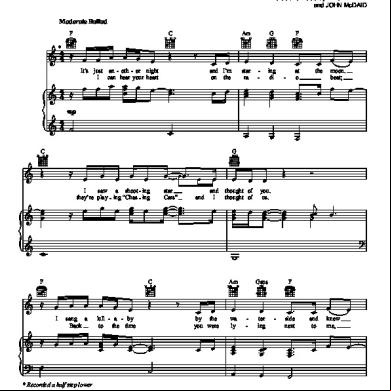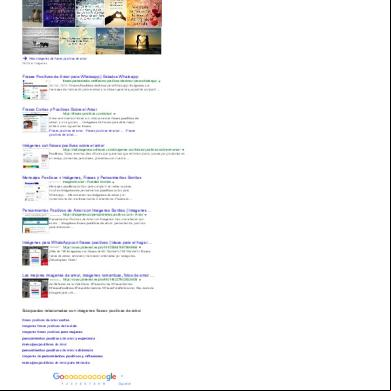Cargo Lashing Pre-sea_ir.ppt 313ho
This document was ed by and they confirmed that they have the permission to share it. If you are author or own the copyright of this book, please report to us by using this report form. Report 3i3n4
Overview 26281t
& View Cargo Lashing Pre-sea_ir.ppt as PDF for free.
More details 6y5l6z
- Words: 804
- Pages: 67
Cargo Securing
“The carrier shall properly and carefully load, handle, stow, carry, keep, care for and discharge the goods carried.” Hague Rules, Articles iii, Rule 2
http://www.ukpandi.com/file/s/uk-pi/
Motions Cargo is subjected to… • • • • • • •
Pitching Rolling Yawing Swaying Heaving Surging Ship’s GM will have an impact (stiff/tender) www.containerhandbook.de .
Cargo Securing Manual CH 1 Definitions CH 2 Securing Devices and Arrangements Fixed & Portable devices Inspection & maintenance schemes CH 3 Stowage & securing of non-standardized and semi standardizes cargo Evaluation of forces acting on cargo units Application of cargo securing devices RoRo ships
Cargo Securing Manual CH 4 Stowage and securing of containers and other standardized cargo Handling and safety instructions Stowage and securing instructions Other allowable stowage patterns Forces acting on cargo units
Internal stowage of containers
Bracing cargo away from the door
Dunnage bracing
Dunnage air bags
Spreader
Gantry Tier
Cell Guide
Pontoon Hatch
Cell Bay
http://www.guinnessworldrecords.com/content_pages/record.asp?recordid=43775
Lashing Bridge
Cell Guides
g n i sh La
ds o R
Container Lashing Manual http://www.containerhandbuch.de/chb_e/stra/index.html?/chb_e/stra/stra_01_03_02.html
Old lashing system- Held down by rods/wires
Securing (twistlock)
Corner Casting
Tensile strength –SWL 20.4t, Proof load 30.6 t Break Load 40.4 t
TShear strength –SWL 15.3t, Proof load 22.9 t Break Load 30.6 t
http://www.containerhandbuch.de/chb_e/stra/index.html?/chb_e/stra/stra_01_03_02.html
http://www.containerhandbuch.de/chb_e/stra/index.html?/chb_e/stra/stra_01_03_02.html
http://www.marinesurveyorbrisbane.com/ppw-4.htm
Prudent loading checks • Correct stowage by stevedores • Dunnage as required • Appropriate lashing
Lashing strengths (Deck)
Vertical Strength
Horizontal Athwartships Strength
Horizontal Fore & Aft Strength
3 X Wt of cargo 3 x Wt x 0.7 3 x Wt x 0.3
Cargo Securing methods • • • • • •
Tomming Lashing Anti-skid mats Structural alterations Filling Air bags
Bliault, C. & Nth of England P&I Association (2003)
Ratchet and web lashing
Lashing Chains
Knot, R. (2002) Lashing and Securing Deck cargoes. UK: Nautical Institute
Knot, R. (2002) Lashing and Securing Deck cargoes. UK: Nautical Institute
Knot, R. (2002) Lashing and Securing Deck cargoes. UK: Nautical Institute
Never saddle a dead horse
Spaced 6 rope diameters apart Min 3 grips 16mm-19mm wire
Knot, R. (2002) Lashing and Securing Deck cargoes. UK: Nautical Institute
References • MO Part 42 • CSS Code (Code of Safe Practice for Cargo Stowage & Securing) IMO • Lashing and Securing of Deck Cargoes (John Knott) • Ship’s Cargo Securing Manual
Knot, R. (2002) Lashing and Securing Deck cargoes. UK: Nautical Institute
Knot, R. (2002) Lashing and Securing Deck cargoes. UK: Nautical Institute
Knot, R. (2002) Lashing and Securing Deck cargoes. UK: Nautical Institute
Knot, R. (2002) Lashing and Securing Deck cargoes. UK: Nautical Institute
Figure 41: Cargo loaded into an ocean-going ship. Some of the boxes are stacked three deep. Such good stowage cannot, however, always be expected. The boxes are wedged together for the voyage. Some of the boxes have clearly been exposed to rain before loading. One very good alternative to film under the box lid is tarred board on top of the box lid. http://www.tis-gdv.de/tis_e/ware/maschinen/maschinen/maschinen.htm#ls
Figure 32: This engine manufacturer has complied with all recommendations. Each engine has such a plan. This plan makes it clear to all involved how the engines are to be lifted and lashed correctly (see Figure 42). This approach should ideally be used for all heavy-lift shipments. http://www.tis-gdv.de/tis_e/ware/maschinen/maschinen/maschinen.htm#ls
Figure 42: Using the details shown in Figure 32, the cargo can now be properly secured.
http://www.tis-gdv.de/tis_e/ware/maschinen/maschinen/maschinen.htm#ls
Figure 33: This is how it should look when lashing points are indicated by the manufacturer.
http://www.marinesurveyorbrisbane.com/ppw-7.htm
Heavy lift project cargo stowage and securing to IMO criteria
Figure 43: A problem arises on a general cargo ship. An engine weighing 200 metric tons is to be loaded into the lower hold. That's no problem from the point of view of space and load per unit area. Unfortunately, the engine cannot be secured because it is impossible to weld lashing eyes onto the floor due to the oil tank located beneath. Such problems need not arise if these issues are discussed in good time.
http://www.tis-gdv.de/tis_e/ware/stahl/coils/coils.htm#ls
Preferred method, Chocked and 1 level
Dunnage provided to stop the load from moving, reduce point loading and protect ship and cargo from damage.
http://www.tis-gdv.de/tis_e/ware/stahl/coils/coils.htm#ls
http://www.tis-gdv.de/tis_e/ware/kfz/lkw/lkw.htm#ls
Figure 12: Deck loading of automobiles and trucks - damage is inevitable. The trucks are stowed too closely together and no wheel chocks have been used. Another feature which merits criticism is the direct securing to adjacent vehicles.
Figure 9: Method for securing trucks on board a ro-ro ship based on [59].
Knot, R. (2002) Lashing and Securing Deck cargoes. UK: Nautical Institute
Figure 10: Method for securing a truck on board a conventional ship, an opentop container, on a flatrack or platform based on [59].
Figure 11: Method for securing a truck on board a conventional ship, an open-top container, on a flatrack or platform based on [59].
Figure 16: Method for securing automobiles on board a ro-ro ship based on [59].
Speed Lashings
“The carrier shall properly and carefully load, handle, stow, carry, keep, care for and discharge the goods carried.” Hague Rules, Articles iii, Rule 2
http://www.ukpandi.com/file/s/uk-pi/
Motions Cargo is subjected to… • • • • • • •
Pitching Rolling Yawing Swaying Heaving Surging Ship’s GM will have an impact (stiff/tender) www.containerhandbook.de .
Cargo Securing Manual CH 1 Definitions CH 2 Securing Devices and Arrangements Fixed & Portable devices Inspection & maintenance schemes CH 3 Stowage & securing of non-standardized and semi standardizes cargo Evaluation of forces acting on cargo units Application of cargo securing devices RoRo ships
Cargo Securing Manual CH 4 Stowage and securing of containers and other standardized cargo Handling and safety instructions Stowage and securing instructions Other allowable stowage patterns Forces acting on cargo units
Internal stowage of containers
Bracing cargo away from the door
Dunnage bracing
Dunnage air bags
Spreader
Gantry Tier
Cell Guide
Pontoon Hatch
Cell Bay
http://www.guinnessworldrecords.com/content_pages/record.asp?recordid=43775
Lashing Bridge
Cell Guides
g n i sh La
ds o R
Container Lashing Manual http://www.containerhandbuch.de/chb_e/stra/index.html?/chb_e/stra/stra_01_03_02.html
Old lashing system- Held down by rods/wires
Securing (twistlock)
Corner Casting
Tensile strength –SWL 20.4t, Proof load 30.6 t Break Load 40.4 t
TShear strength –SWL 15.3t, Proof load 22.9 t Break Load 30.6 t
http://www.containerhandbuch.de/chb_e/stra/index.html?/chb_e/stra/stra_01_03_02.html
http://www.containerhandbuch.de/chb_e/stra/index.html?/chb_e/stra/stra_01_03_02.html
http://www.marinesurveyorbrisbane.com/ppw-4.htm
Prudent loading checks • Correct stowage by stevedores • Dunnage as required • Appropriate lashing
Lashing strengths (Deck)
Vertical Strength
Horizontal Athwartships Strength
Horizontal Fore & Aft Strength
3 X Wt of cargo 3 x Wt x 0.7 3 x Wt x 0.3
Cargo Securing methods • • • • • •
Tomming Lashing Anti-skid mats Structural alterations Filling Air bags
Bliault, C. & Nth of England P&I Association (2003)
Ratchet and web lashing
Lashing Chains
Knot, R. (2002) Lashing and Securing Deck cargoes. UK: Nautical Institute
Knot, R. (2002) Lashing and Securing Deck cargoes. UK: Nautical Institute
Knot, R. (2002) Lashing and Securing Deck cargoes. UK: Nautical Institute
Never saddle a dead horse
Spaced 6 rope diameters apart Min 3 grips 16mm-19mm wire
Knot, R. (2002) Lashing and Securing Deck cargoes. UK: Nautical Institute
References • MO Part 42 • CSS Code (Code of Safe Practice for Cargo Stowage & Securing) IMO • Lashing and Securing of Deck Cargoes (John Knott) • Ship’s Cargo Securing Manual
Knot, R. (2002) Lashing and Securing Deck cargoes. UK: Nautical Institute
Knot, R. (2002) Lashing and Securing Deck cargoes. UK: Nautical Institute
Knot, R. (2002) Lashing and Securing Deck cargoes. UK: Nautical Institute
Knot, R. (2002) Lashing and Securing Deck cargoes. UK: Nautical Institute
Figure 41: Cargo loaded into an ocean-going ship. Some of the boxes are stacked three deep. Such good stowage cannot, however, always be expected. The boxes are wedged together for the voyage. Some of the boxes have clearly been exposed to rain before loading. One very good alternative to film under the box lid is tarred board on top of the box lid. http://www.tis-gdv.de/tis_e/ware/maschinen/maschinen/maschinen.htm#ls
Figure 32: This engine manufacturer has complied with all recommendations. Each engine has such a plan. This plan makes it clear to all involved how the engines are to be lifted and lashed correctly (see Figure 42). This approach should ideally be used for all heavy-lift shipments. http://www.tis-gdv.de/tis_e/ware/maschinen/maschinen/maschinen.htm#ls
Figure 42: Using the details shown in Figure 32, the cargo can now be properly secured.
http://www.tis-gdv.de/tis_e/ware/maschinen/maschinen/maschinen.htm#ls
Figure 33: This is how it should look when lashing points are indicated by the manufacturer.
http://www.marinesurveyorbrisbane.com/ppw-7.htm
Heavy lift project cargo stowage and securing to IMO criteria
Figure 43: A problem arises on a general cargo ship. An engine weighing 200 metric tons is to be loaded into the lower hold. That's no problem from the point of view of space and load per unit area. Unfortunately, the engine cannot be secured because it is impossible to weld lashing eyes onto the floor due to the oil tank located beneath. Such problems need not arise if these issues are discussed in good time.
http://www.tis-gdv.de/tis_e/ware/stahl/coils/coils.htm#ls
Preferred method, Chocked and 1 level
Dunnage provided to stop the load from moving, reduce point loading and protect ship and cargo from damage.
http://www.tis-gdv.de/tis_e/ware/stahl/coils/coils.htm#ls
http://www.tis-gdv.de/tis_e/ware/kfz/lkw/lkw.htm#ls
Figure 12: Deck loading of automobiles and trucks - damage is inevitable. The trucks are stowed too closely together and no wheel chocks have been used. Another feature which merits criticism is the direct securing to adjacent vehicles.
Figure 9: Method for securing trucks on board a ro-ro ship based on [59].
Knot, R. (2002) Lashing and Securing Deck cargoes. UK: Nautical Institute
Figure 10: Method for securing a truck on board a conventional ship, an opentop container, on a flatrack or platform based on [59].
Figure 11: Method for securing a truck on board a conventional ship, an open-top container, on a flatrack or platform based on [59].
Figure 16: Method for securing automobiles on board a ro-ro ship based on [59].
Speed Lashings










